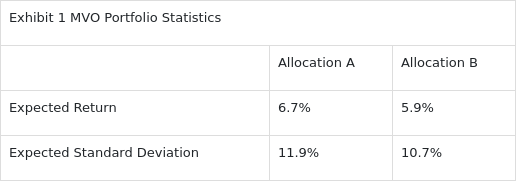NO.PZ2018031301000003
问题如下:
John Tomb is an investment advisor at an asset management firm. He is developing an asset allocation for James Youngmall, a client of the firm. Tomb considers two possible allocations for Youngmall. Allocation A consists of four asset classes: cash, US bonds, US equities, and global equities. Allocation B includes these same four asset classes, as well as global bonds. Youngmall has a relatively low risk tolerance with a risk aversion coefficient (λ) of 7. Tomb runs mean–variance optimization (MVO) to maximize the following utility function to determine the preferred allocation for Youngmall:
Um= E(R)- 0.005λσm2
The resulting MVO statistics for the two asset allocations are presented in Exhibit 1.

Determine which allocation in Exhibit 1 Tomb should recommend to Youngmall. Justify your response.
解释:
Tomb should
recommend Allocation B.
The expected utility of Allocation B is 1.89%, which is
higher than Allocation A’s expected utility of 1.74%.
MVO provides a framework to determine how much to
allocate to each asset class or to create the optimal asset mix. The given
objective function is:
Um= E(R)- 0.005λσm2
Using the given objective
function and the expected returns and expected standard deviations for Allocations
A and B, the expected utilities (certainty equivalent returns) for the two
allocations are calculated as:
Allocation A: 6.7% – 0.005 (7) (11.9%)2 =
1.74%
Allocation B: 5.9% – 0.005 (7) (10.7%)2 =
1.89%
Therefore, Tomb should recommend Allocation B because it
results in higher expected utility than Allocation A.
老师除了 效用最大化的理由,可否再加一条更加diversified,更适合risk averse的这位客户?
此外,如果在考试中,如果题目没要求计算过程,是不是把结果写上即可?



